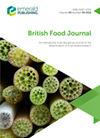一天一苹果能否远离 COVID-19?关于 COVID-19 大流行对意大利苹果消费的长期影响的聚类分析
IF 3.4
3区 经济学
Q1 AGRICULTURAL ECONOMICS & POLICY
引用次数: 0
摘要
目的 苹果一直被认为是一种健康产品,能够为消费者提供治疗功效。在意大利,无论是作为新鲜产品还是作为加工食品,苹果的消费和生产都有着悠久的传统。然而,与许多其他产品一样,水果和蔬菜,特别是苹果的消费受到了 2020 年第一次封锁的严重影响。在本项目中,作者调查了消费习惯的改变是否会在 2020 年之后产生长期影响,以及大流行后影响果蔬消费的主要饮食动机、食品相关行为和社会人口学因素是什么。在研究中,参与者回答了有关其消费习惯和饮食动机的问题。在这 1000 名消费者中,作者只将回答了两次调查的参与者纳入最终分析,最后得出 651 名消费者的样本。此外,消费者表示苹果的消费量平均有所增加。然而,年龄在 30 至 50 岁之间且被认定为女性的消费者的苹果消费量增长更为明显。在显示了不同时间段的差异后,聚类分析确定了在饮食动机、购买地点和居住地区方面存在差异的三个主要群体。原创性/价值 据作者所知,这是第一项在 COVID-19 大流行开始一年多后调查意大利水果和蔬菜消费变化的研究,更具体地说,是调查苹果消费变化的研究。此外,该研究还根据消费者在 COVID-19 大流行最低潮时期的习惯对他们进行了分类,这在目前的文献中是没有的。本文章由计算机程序翻译,如有差异,请以英文原文为准。
Can an apple a day keep COVID-19 away? A cluster analysis of the long-term COVID-19 pandemic’s impact on the consumption of apples in Italy
PurposeApples have always been considered a healthy product able to provide curative properties to consumers. In Italy, there is a long tradition of apple consumption and production both as a fresh product and as processed food. However, as with many other products, the consumption of fruits and vegetables and, more specifically apples, has been drastically affected by the first lockdown in 2020. In this project, the authors investigate whether the change in consumption habits had long-lasting consequences beyond 2020 and what are the main eating motivations, food-related behavior and socio-demographic affecting the consumption of fruits and vegetables after the pandemic.Design/methodology/approachThe authors ran two online surveys with 1,000 Italian consumers across a year (from October 2021 to December 2022). In the study, participants answered questions about their consumption habits and their eating motives. Out of 1,000 consumers, the authors included in the final analysis only the participants who answered both surveys, leaving a final sample of 651 consumers.FindingsThe results show that participants have allocated more budget to fruit and vegetables after the lockdown than before it. Moreover, consumers reported an average increase in the consumption of apples. However, the increase was more pronounced for people aged between 30 and 50 years old and identified as female. After showing the difference across time, a cluster analysis identified three main segments that differ in their eating motives, place of purchase and area of residence.Practical implicationsOverall, the results contribute to a better understanding of how the global pandemic is still affecting people's daily life. Moreover, the findings can be used to guide the marketing and communication strategies of companies in the food sector.Originality/valueTo the best of the authors' knowledge, this is the first study that investigates changes in the consumption of fruits and vegetables, and, more specifically, apples, in Italy more than one year after the beginning of the COVID-19 pandemic. Moreover, the study proposes a classification of consumers based on their habits in a time frame during which the COVID-19 wave was at its bottom which is not currently present in the literature.
求助全文
通过发布文献求助,成功后即可免费获取论文全文。
去求助
来源期刊

British Food Journal
工程技术-食品科技
CiteScore
6.90
自引率
15.20%
发文量
219
审稿时长
18-36 weeks
期刊介绍:
After 115 years, the British Food Journal (BFJ) continues to be highly respected worldwide for its broad and unique interdisciplinary coverage of the latest food-related double blind peer-reviewed research. It links all sectors of this dynamic industry, keeping abreast of emerging trends, topical and controversial issues and informing and stimulating debate. - See more at: http://emeraldgrouppublishing.com/products/journals/journals.htm?id=bfj#sthash.O3wH4pEh.dpuf
 求助内容:
求助内容: 应助结果提醒方式:
应助结果提醒方式:


